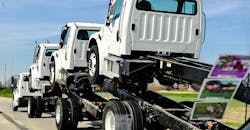NTEA: Vehicle lightweighting is a critical path to success
The National Truck Equipment Association (NTEA) recently published the following white paper on vehicle lightweighting:
Vehicle operations are no exception to the continuous improvement goal of doing more while spending less. Reducing vehicle weight provides organizations with opportunities to keep enhancing operational efficiencies. Weight has direct influence on regulatory compliance for motor vehicle safety, emissions and Bridge Law limitations, in addition to operational elements such as motor carrier/driver requirements, maintenance and vehicle life cycle. It’s a critical factor in the acquisition process. This overview primarily focuses on vehicles with a gross vehicle weight rating (GVWR) of 10,000 pounds or less.
As driver regulations (such as electronic data logging for hours of service and other qualifications) increase, the trend to downsize into vehicles with a GVWR of 10,000 pounds or less (Class 1–2) continues. Use of lighter-weight chassis and bodies to reduce a truck’s unloaded weight, while maintaining payload capacity of a larger GVWR truck, is a major consideration. Although acquisition of a lower GVWR chassis does not necessarily translate into a lower overall chassis cost, the upfront price of lightweight materials for truck bodies to preserve or improve payload capacity can be compared to the ongoing operational fees subject to vehicles with GVWRs over 10,000 pounds.
Another factor related to this trend is the current labor market. Efforts to recruit and maintain good employees have led organizations with work truck drivers to view smaller, lighter vehicles with a more comfortable interior as a competitive edge (especially in situations where employees take vehicles home).
However, these operational benefits can be more apparent than some of the limitations on what multistage manufacturers can provide to customers looking to downsize from a Class 3 vehicle. Work truck manufacturers must comply with many other Federal Motor Vehicle Safety Standards (FMVSS) that apply to Class 1–2 vehicles as required by the National Highway Traffic Safety Administration (NHTSA).
As weight also is a direct factor in the energy a vehicle must manage in a crash, in addition to braking and handling, smaller vehicles have more FMVSS to protect their occupants and optimize dynamic performance. Many of these FMVSS limit the completed work truck’s maximum unloaded vehicle weight (UVW). Maximum UVW limits are based on chassis OEM compliance to specific standards like FMVSS 126: Electronic Stability Control; FMVSS 208: Occupant Crash Protection; FMVSS 212: Windshield Mounting; FMVSS 214: Side Impact Protection; FMVSS 216: Roof Crush Resistance; FMVSS 219: Windshield Zone Intrusion; and FMVSS 301: Fuel System Integrity.
For some applications, this means lightweighting bodies and/or equipment is the only way a multistage manufacturer can build on a particular Class 1 or 2 vehicle platform to remain within maximum UVW limitations. Beyond the weight itself, weight distribution has FMVSS limitations as it relates to the center of gravity location, which can influence a vehicle’s crash and braking performance. A maximum vertical limit for overall center of gravity is a common performance requirement for multistage manufacturers to maintain braking system compliance. For certain barrier tests, a similar limit can be required for the body portion of a lighter vehicle. Lightweighting can help keep an application viable by minimizing center of gravity height.
Maximum UVW also plays a role in Environmental Protection Agency (EPA) greenhouse gas emissions and NHTSA fuel economy regulations, which have caused chassis manufacturers to place strict requirements on maximum UVW and frontal area for the completed vehicle. These EPA and NHTSA limitations extend up to 14,000 pounds GVWR, but are more restrictive for Class 1–2 vehicles. While frontal area limitations can be more challenging, lightweight body materials can help overcome maximum UVW limitations in meeting these requirements.
Working with potential upfitters can be a productive way to approach lightweighting. Together, you can explore chassis/body/equipment options that can be produced to maintain regulatory compliance (as determined by applicable FMVSS and EPA standards), while providing needed payload capacity and operational efficiency. For example, if a lower GVWR vehicle upfit would still have a payload so limiting that additional trips and/or vehicles are needed to do the same work as the original higher GVWR truck, it may not be a good lightweighting candidate.
However, if your equipment, payload and performance needs can be met using a lighter weight chassis with a work truck body that incorporates lighter weight materials (like high-strength steel, aluminum or composites that meet longevity and durability requirements), this can be a great opportunity to help your fleet’s operational flexibility.
Learn more
NTEA offers access to publications and reference materials on current regulations, safety standards and other technical issues at ntea.com. To learn more about the tools, resources and solutions available to members, visit ntea.com/memberbenefits.
Green Truck Association (GTA), an NTEA affiliate division, offers a variety of resources to educate its members on techniques and technology that can improve fleet efficiency, reduce emissions across time, and lower the risk of fuel price volatility driving up operating expenses.
GTA fleet members can get involved in a data logger drive and duty cycle program that provides information on how vehicles operate in varying environments. Find details at greentruckassociation.com.
T09 upf X
NTEA lightweighting technical paper.jpg
